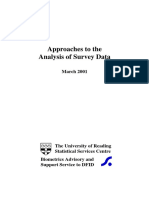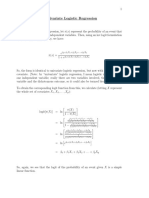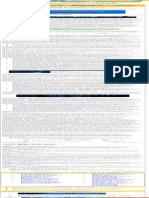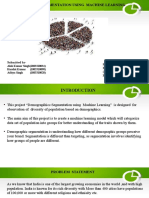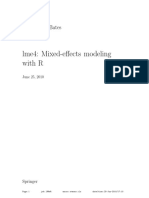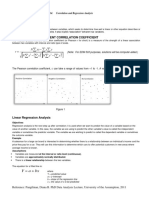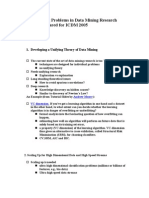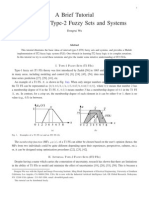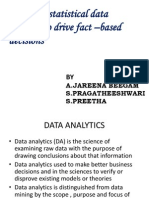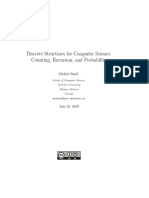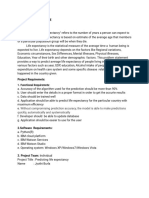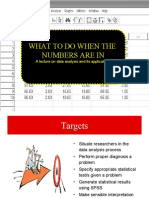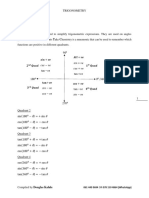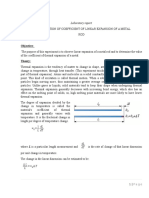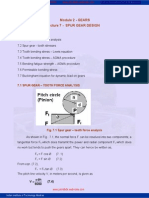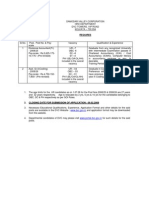Lecture 2: Descriptive Statistics and Exploratory Data Analysis
Further Thoughts on Experimental Design
16 Individuals (8 each from two populations) with replicates
Pop 1
Pop 2 Randomly sample 4 individuals from each pop Tissue culture and RNA extraction Labeling and array hybridization Slide scanning and data acquisition Repeat 2 times processing 16 samples in total Repeat entire process producing 2 technical replicates for all 16 samples
�Other Business
Course web-site:
http://www.gs.washington.edu/academics/courses/akey/56008/index.htm
Homework due on Thursday not Tuesday
Make sure you look at HW1 soon and see either Shameek or myself with questions
�Today
What is descriptive statistics and exploratory data analysis? Basic numerical summaries of data Basic graphical summaries of data How to use R for calculating descriptive statistics and making graphs
�Central Dogma of Statistics
Probability
Population
Descriptive Statistics
Sample
Inferential Statistics
�EDA
Before making inferences from data it is essential to examine all your variables. Why? To listen to the data: - to catch mistakes - to see patterns in the data - to nd violations of statistical assumptions - to generate hypotheses and because if you dont, you will have trouble later
�Types of Data
Categorical Quantitative
binary
2 categories
nominal
ordinal
discrete
continuous
more categories order matters numerical uninterrupted
�Dimensionality of Data Sets
Univariate: Measurement made on one variable per subject Bivariate: Measurement made on two variables per subject
Multivariate: Measurement made on many variables per subject
�Numerical Summaries of Data
Central Tendency measures. They are computed to give a center around which the measurements in the data are distributed. Variation or Variability measures. They describe data spread or how far away the measurements are from the center. Relative Standing measures. They describe the relative position of specic measurements in the data.
�Location: Mean
1. The Mean To calculate the average x of a set of observations, add their value and divide by the number of observations:
x1 + x 2 + x 3 + ... + x n 1 x= = " xi n n i=1
�Other Types of Means
Weighted means:
n
Trimmed:
x ="
"w x
i
x=
i= 1 n
"w
i= 1
Geometric:
# & x = %" x i ( $ i=1 '
n 1 n
Harmonic:
x= n 1 "x i= 1 i
n
�Location: Median
Median the exact middle value Calculation:
- If there are an odd number of observations, nd the middle value - If there are an even number of observations, nd the middle two values and average them
Example
Some data: Age of participants: 17 19 21 22 23 23 23 38 Median = (22+23)/2 = 22.5
�Which Location Measure Is Best?
Mean is best for symmetric distributions without outliers Median is useful for skewed distributions or data with outliers
0 1 2 3 4 5 6 7 8 9 10 0 1 2 3 4 5 6 7 8 9 10
Mean = 3 Median = 3
Mean = 4 Median = 3
�Scale: Variance
Average of squared deviations of values from the mean
n
2 " =
$( x
i
# x)
n #1
�Why Squared Deviations?
Adding deviations will yield a sum of ? Absolute values do not have nice mathematical properties Squares eliminate the negatives Result:
Increasing contribution to the variance as you go farther from the mean.
�Scale: Standard Deviation
Variance is somewhat arbitrary What does it mean to have a variance of 10.8? Or 2.2? Or 1459.092? Or 0.000001? Nothing. But if you could standardize that value, you could talk about any variance (i.e. deviation) in equivalent terms Standard deviations are simply the square root of the variance
�Scale: Standard Deviation
n 2 ( x # x ) $ i i
= "
n #1
1. Score (in the units that are meaningful) 2. Mean ! 3. Each scores deviation from the mean 4. Square that deviation 5. Sum all the squared deviations (Sum of Squares) 6. Divide by n-1 7. Square root now the value is in the units we started with!!!
�Interesting Theoretical Result
Regardless of how the data are distributed, a certain percentage of values must fall within k standard deviations from the mean:
Note use of (sigma) to represent standard deviation.
Note use of (mu) to represent mean.
At least
within
(1 - 1/12) = 0% ... k=1 ( 1) (1 - 1/22) = 75% ........ k=2 ( 2) (1 - 1/32) = 89% ....k=3 ( 3)
�Often We Can Do Better
For many lists of observations especially if their histogram is bell-shaped 1. Roughly 68% of the observations in the list lie within 1 standard deviation of the average 2. 95% of the observations lie within 2 standard deviations of the average
Average Ave+s.d. Ave+2s.d.
Ave-2s.d.
Ave-s.d.
68% 95%
�Scale: Quartiles and IQR
IQR
25% 25% 25% 25%
Q1
Q2
Q3
The rst quartile, Q1, is the value for which 25% of the observations are smaller and 75% are larger Q2 is the same as the median (50% are smaller, 50% are larger) Only 25% of the observations are greater than the third quartile
�Percentiles (aka Quantiles)
In general the nth percentile is a value such that n% of the observations fall at or below or it
n%
Q1 = 25th percentile Median = 50th percentile Q2 = 75th percentile
�Graphical Summaries of Data
A (Good) Picture Is Worth A 1,000 Words
�Univariate Data: Histograms and Bar Plots
Whats the difference between a histogram and bar plot? Bar plot
Used for categorical variables to show frequency or proportion in each category. Translate the data from frequency tables into a pictorial representation
Histogram
Used to visualize distribution (shape, center, range, variation) of continuous variables Bin size important
�Effect of Bin Size on Histogram
Simulated 1000 N(0,1) and 500 N(1,1)
Frequency
Frequency
Frequency
�More on Histograms
Whats the difference between a frequency histogram and a density histogram?
�More on Histograms
Whats the difference between a frequency histogram and a density histogram?
Frequency Histogram Density Histogram
�Box Plots
100.0
maximum
66.7
Q3 IQR median Q1
Years
33.3
minimum
0.0
AGE
Variables
�Bivariate Data
Variable 1
Categorical
Variable 2
Categorical
Display
Crosstabs Stacked Box Plot
Categorical Continuous
Continuous Continuous
Boxplot Scatterplot Stacked Box Plot
�Multivariate Data
Clustering Organize units into clusters Descriptive, not inferential Many approaches Clusters always produced Data Reduction Approaches (PCA) Reduce n-dimensional dataset into much smaller number Finds a new (smaller) set of variables that retains most of the information in the total sample Effective way to visualize multivariate data
�How to Make a Bad Graph
The aim of good data graphics:
Display data accurately and clearly
Some rules for displaying data badly:
Display as little information as possible Obscure what you do show (with chart junk) Use pseudo-3d and color gratuitously Make a pie chart (preferably in color and 3d) Use a poorly chosen scale
From Karl Broman: http://www.biostat.wisc.edu/~kbroman/
�Example 1
�Example 2
�Example 3
�Example 4
�Example 5
�R Tutorial
Calculating descriptive statistics in R Useful R commands for working with multivariate data (apply and its derivatives) Creating graphs for different types of data (histograms, boxplots, scatterplots) Basic clustering and PCA analysis
